History of South East Asia: Cold War Impact and Global Relations
VerifiedAdded on 2022/10/06
|8
|2139
|20
Essay
AI Summary
This essay delves into the rich and complex history of South East Asia, examining its geographical diversity, the influence of the Cold War, and its relationship with global powers, particularly the United States. It explores the impact of the Cold War on the region, including the rise of communism, military spending, and the effects of decolonization. The essay also discusses the Vietnam War, the role of art and film in shaping perceptions and ideologies, and the broader implications of the Cold War on the region's development and international relations. The author concludes by highlighting the lasting impact of the Cold War and the emergence of new global conflicts, such as the potential for a new Cold War between the US and China, underscoring the ongoing relevance of historical analysis in understanding contemporary global dynamics. The essay draws upon a variety of sources, including academic articles and books, to support its arguments.
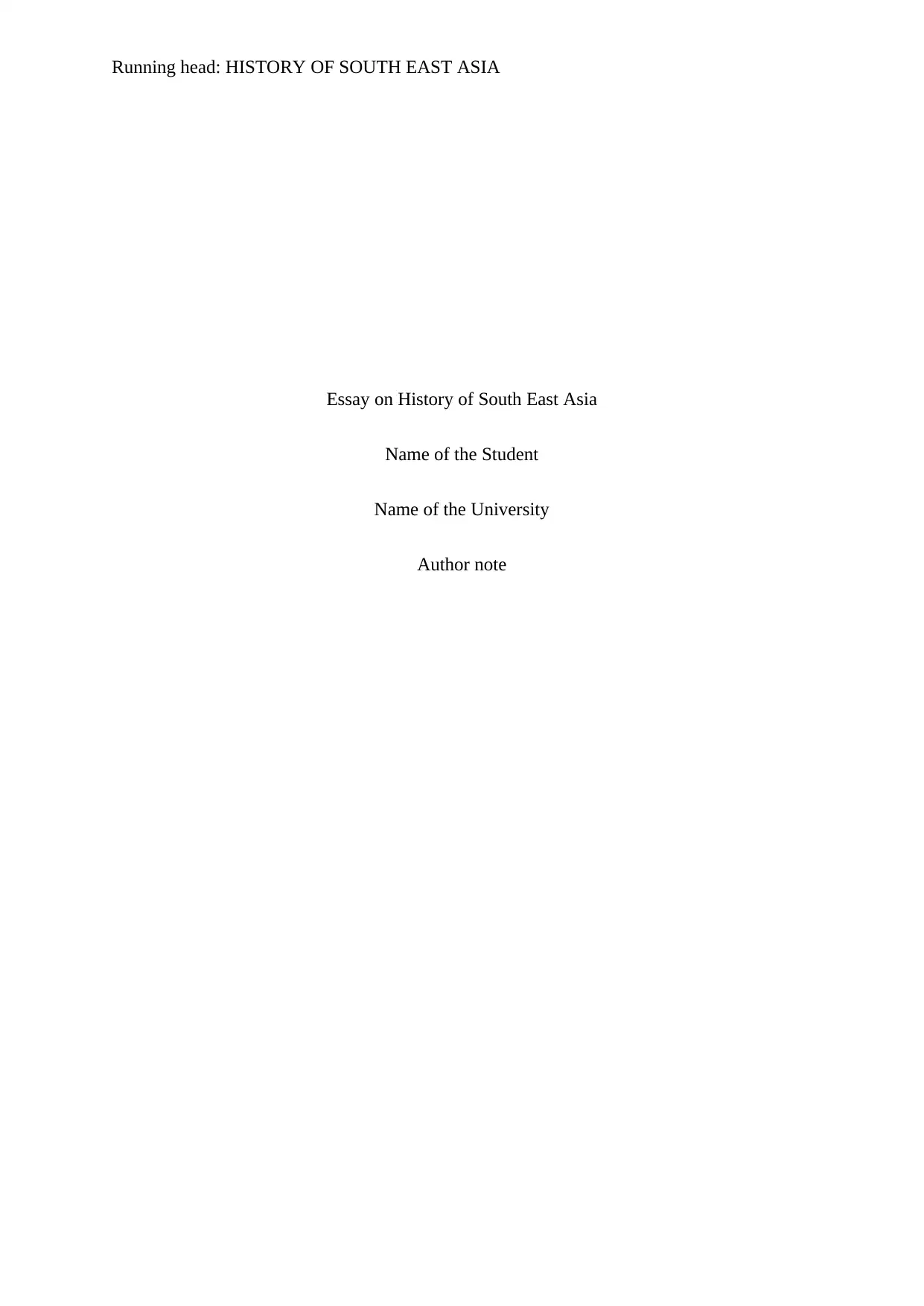
Running head: HISTORY OF SOUTH EAST ASIA
Essay on History of South East Asia
Name of the Student
Name of the University
Author note
Essay on History of South East Asia
Name of the Student
Name of the University
Author note
Paraphrase This Document
Need a fresh take? Get an instant paraphrase of this document with our AI Paraphraser
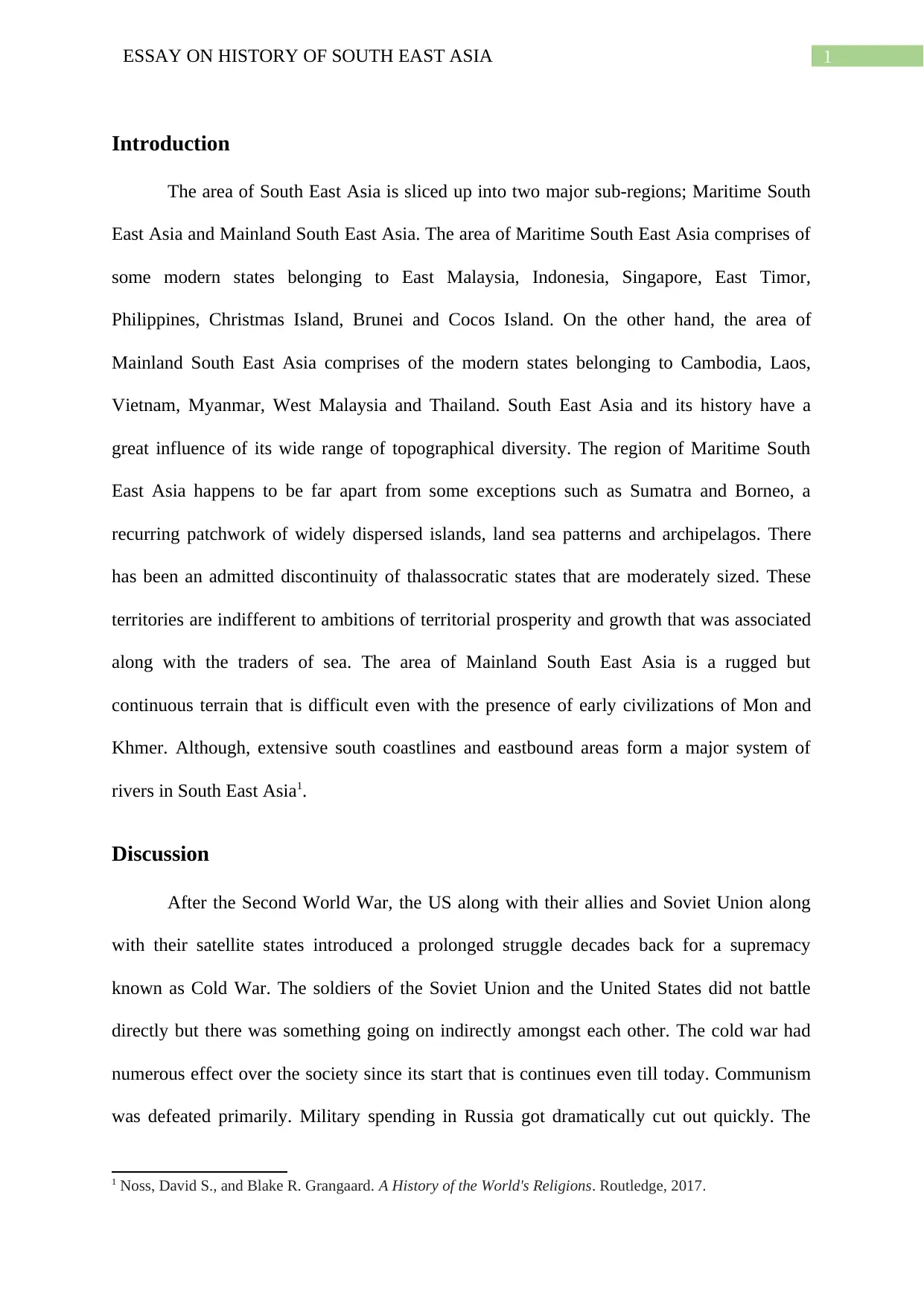
1ESSAY ON HISTORY OF SOUTH EAST ASIA
Introduction
The area of South East Asia is sliced up into two major sub-regions; Maritime South
East Asia and Mainland South East Asia. The area of Maritime South East Asia comprises of
some modern states belonging to East Malaysia, Indonesia, Singapore, East Timor,
Philippines, Christmas Island, Brunei and Cocos Island. On the other hand, the area of
Mainland South East Asia comprises of the modern states belonging to Cambodia, Laos,
Vietnam, Myanmar, West Malaysia and Thailand. South East Asia and its history have a
great influence of its wide range of topographical diversity. The region of Maritime South
East Asia happens to be far apart from some exceptions such as Sumatra and Borneo, a
recurring patchwork of widely dispersed islands, land sea patterns and archipelagos. There
has been an admitted discontinuity of thalassocratic states that are moderately sized. These
territories are indifferent to ambitions of territorial prosperity and growth that was associated
along with the traders of sea. The area of Mainland South East Asia is a rugged but
continuous terrain that is difficult even with the presence of early civilizations of Mon and
Khmer. Although, extensive south coastlines and eastbound areas form a major system of
rivers in South East Asia1.
Discussion
After the Second World War, the US along with their allies and Soviet Union along
with their satellite states introduced a prolonged struggle decades back for a supremacy
known as Cold War. The soldiers of the Soviet Union and the United States did not battle
directly but there was something going on indirectly amongst each other. The cold war had
numerous effect over the society since its start that is continues even till today. Communism
was defeated primarily. Military spending in Russia got dramatically cut out quickly. The
1 Noss, David S., and Blake R. Grangaard. A History of the World's Religions. Routledge, 2017.
Introduction
The area of South East Asia is sliced up into two major sub-regions; Maritime South
East Asia and Mainland South East Asia. The area of Maritime South East Asia comprises of
some modern states belonging to East Malaysia, Indonesia, Singapore, East Timor,
Philippines, Christmas Island, Brunei and Cocos Island. On the other hand, the area of
Mainland South East Asia comprises of the modern states belonging to Cambodia, Laos,
Vietnam, Myanmar, West Malaysia and Thailand. South East Asia and its history have a
great influence of its wide range of topographical diversity. The region of Maritime South
East Asia happens to be far apart from some exceptions such as Sumatra and Borneo, a
recurring patchwork of widely dispersed islands, land sea patterns and archipelagos. There
has been an admitted discontinuity of thalassocratic states that are moderately sized. These
territories are indifferent to ambitions of territorial prosperity and growth that was associated
along with the traders of sea. The area of Mainland South East Asia is a rugged but
continuous terrain that is difficult even with the presence of early civilizations of Mon and
Khmer. Although, extensive south coastlines and eastbound areas form a major system of
rivers in South East Asia1.
Discussion
After the Second World War, the US along with their allies and Soviet Union along
with their satellite states introduced a prolonged struggle decades back for a supremacy
known as Cold War. The soldiers of the Soviet Union and the United States did not battle
directly but there was something going on indirectly amongst each other. The cold war had
numerous effect over the society since its start that is continues even till today. Communism
was defeated primarily. Military spending in Russia got dramatically cut out quickly. The
1 Noss, David S., and Blake R. Grangaard. A History of the World's Religions. Routledge, 2017.
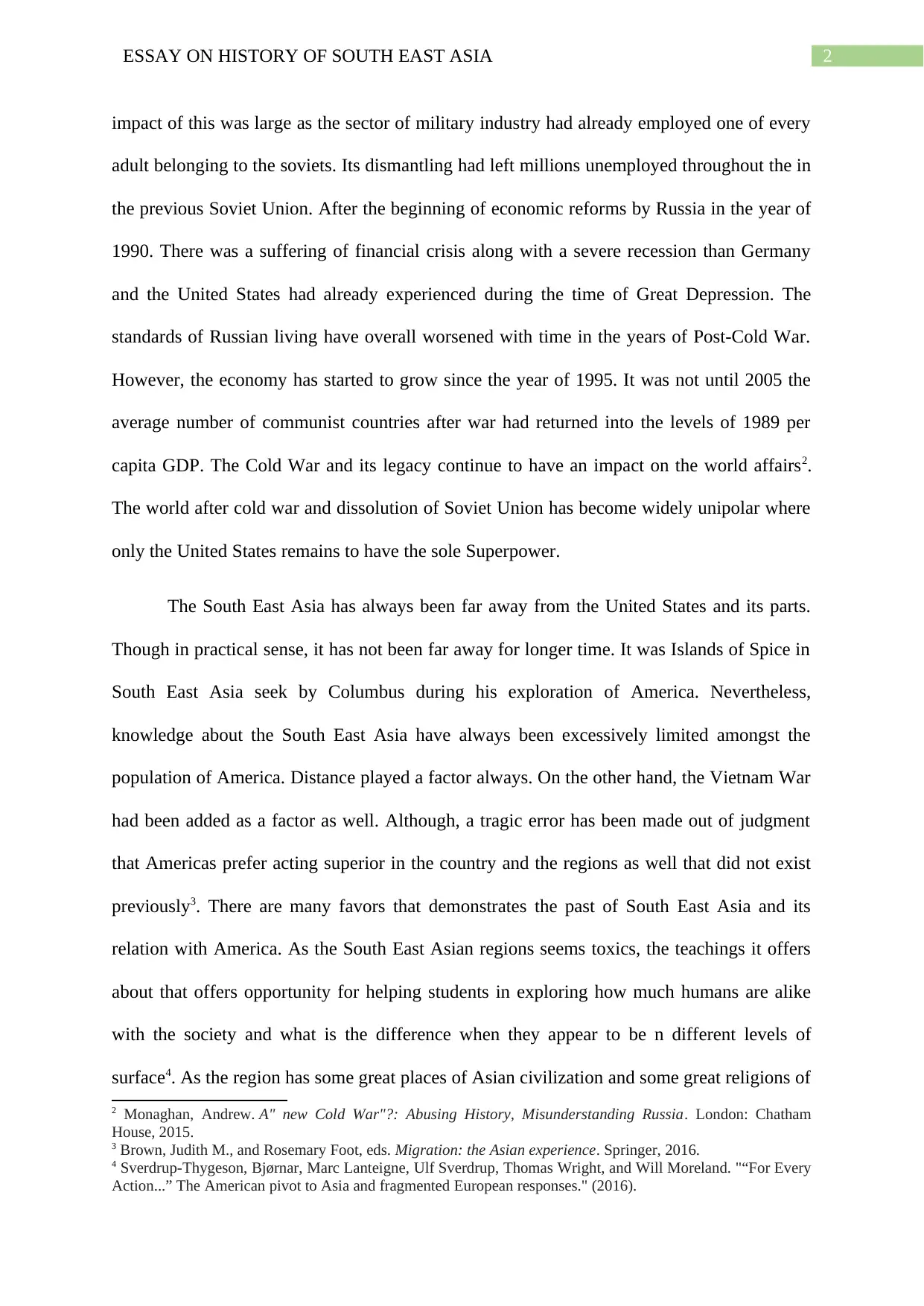
2ESSAY ON HISTORY OF SOUTH EAST ASIA
impact of this was large as the sector of military industry had already employed one of every
adult belonging to the soviets. Its dismantling had left millions unemployed throughout the in
the previous Soviet Union. After the beginning of economic reforms by Russia in the year of
1990. There was a suffering of financial crisis along with a severe recession than Germany
and the United States had already experienced during the time of Great Depression. The
standards of Russian living have overall worsened with time in the years of Post-Cold War.
However, the economy has started to grow since the year of 1995. It was not until 2005 the
average number of communist countries after war had returned into the levels of 1989 per
capita GDP. The Cold War and its legacy continue to have an impact on the world affairs2.
The world after cold war and dissolution of Soviet Union has become widely unipolar where
only the United States remains to have the sole Superpower.
The South East Asia has always been far away from the United States and its parts.
Though in practical sense, it has not been far away for longer time. It was Islands of Spice in
South East Asia seek by Columbus during his exploration of America. Nevertheless,
knowledge about the South East Asia have always been excessively limited amongst the
population of America. Distance played a factor always. On the other hand, the Vietnam War
had been added as a factor as well. Although, a tragic error has been made out of judgment
that Americas prefer acting superior in the country and the regions as well that did not exist
previously3. There are many favors that demonstrates the past of South East Asia and its
relation with America. As the South East Asian regions seems toxics, the teachings it offers
about that offers opportunity for helping students in exploring how much humans are alike
with the society and what is the difference when they appear to be n different levels of
surface4. As the region has some great places of Asian civilization and some great religions of
2 Monaghan, Andrew. A" new Cold War"?: Abusing History, Misunderstanding Russia. London: Chatham
House, 2015.
3 Brown, Judith M., and Rosemary Foot, eds. Migration: the Asian experience. Springer, 2016.
4 Sverdrup-Thygeson, Bjørnar, Marc Lanteigne, Ulf Sverdrup, Thomas Wright, and Will Moreland. "“For Every
Action...” The American pivot to Asia and fragmented European responses." (2016).
impact of this was large as the sector of military industry had already employed one of every
adult belonging to the soviets. Its dismantling had left millions unemployed throughout the in
the previous Soviet Union. After the beginning of economic reforms by Russia in the year of
1990. There was a suffering of financial crisis along with a severe recession than Germany
and the United States had already experienced during the time of Great Depression. The
standards of Russian living have overall worsened with time in the years of Post-Cold War.
However, the economy has started to grow since the year of 1995. It was not until 2005 the
average number of communist countries after war had returned into the levels of 1989 per
capita GDP. The Cold War and its legacy continue to have an impact on the world affairs2.
The world after cold war and dissolution of Soviet Union has become widely unipolar where
only the United States remains to have the sole Superpower.
The South East Asia has always been far away from the United States and its parts.
Though in practical sense, it has not been far away for longer time. It was Islands of Spice in
South East Asia seek by Columbus during his exploration of America. Nevertheless,
knowledge about the South East Asia have always been excessively limited amongst the
population of America. Distance played a factor always. On the other hand, the Vietnam War
had been added as a factor as well. Although, a tragic error has been made out of judgment
that Americas prefer acting superior in the country and the regions as well that did not exist
previously3. There are many favors that demonstrates the past of South East Asia and its
relation with America. As the South East Asian regions seems toxics, the teachings it offers
about that offers opportunity for helping students in exploring how much humans are alike
with the society and what is the difference when they appear to be n different levels of
surface4. As the region has some great places of Asian civilization and some great religions of
2 Monaghan, Andrew. A" new Cold War"?: Abusing History, Misunderstanding Russia. London: Chatham
House, 2015.
3 Brown, Judith M., and Rosemary Foot, eds. Migration: the Asian experience. Springer, 2016.
4 Sverdrup-Thygeson, Bjørnar, Marc Lanteigne, Ulf Sverdrup, Thomas Wright, and Will Moreland. "“For Every
Action...” The American pivot to Asia and fragmented European responses." (2016).
⊘ This is a preview!⊘
Do you want full access?
Subscribe today to unlock all pages.

Trusted by 1+ million students worldwide

3ESSAY ON HISTORY OF SOUTH EAST ASIA
world as well, the place offers an opportunity to acknowledge human relation problems
similar to what America faces. The region of South East Asia also consists of more Latin
American people and Sub-Sahara African people that make it one major region of the world
amongst others.
The decolonization in South East Asia demanded for a strong independence. The c old
war had responses on the leader of third world across Asia, Africa and Latin America. The
people of South East Asia managed maintaining a certain sense of independence from the
Cold War. The cold war had a massive impact on South East Asian people. Efforts have been
shown by the art workers of Southeast Asia who got engaged into their own individual war
which was against enormity of cold war5. It had threated on reducing their creativity
endeavors into some mere apparatus of ideology into warring blocs. A fluid positioning of
this kind was visible at levels of everyday life during the cold war in south east Asia. The
southeast Asian representation as a multicultural country of harmony had served to hide a fact
that region of southeast Asia has been severely torn for the differences in ideology at brink of
one possible war that is regional. The filmmakers in region at that time were co-opted
systematically by the efforts made for crushing the communist movement of Huk in the
region of Philippines through producing films6. The films served as mouthpiece or voice of
capitalist ideologies of the liberals at that time. During the period of cold war in South East
Asia, often the country is perceived as one of the Golden Age for films of Filipino. The
industry of film at that time got mobilized as vehicle for ideologies provided by the state
itself for gaining the sympathy of public into the war against the rebellion of communists.
However, a surface that seemed as a struggling ideology was more complex in reality. A
sensation of unity and coherence were produced by the films at the hour when south east Asia
5 Day, Tony, and Maya Hian Ting Liem, eds. Cultures at war: The Cold War and cultural expression in
Southeast Asia. No. 51. SEAP Publications, 2010.
6 Christopher E. Goscha and Christian F. Ostermann (eds.), Connecting histories: decolonization and the Cold
War in Southeast Asia, 1945-1962, Washington, DC: Woodrow Wilson Center Press; Stanford, CA: Stanford
University Press, c2009
world as well, the place offers an opportunity to acknowledge human relation problems
similar to what America faces. The region of South East Asia also consists of more Latin
American people and Sub-Sahara African people that make it one major region of the world
amongst others.
The decolonization in South East Asia demanded for a strong independence. The c old
war had responses on the leader of third world across Asia, Africa and Latin America. The
people of South East Asia managed maintaining a certain sense of independence from the
Cold War. The cold war had a massive impact on South East Asian people. Efforts have been
shown by the art workers of Southeast Asia who got engaged into their own individual war
which was against enormity of cold war5. It had threated on reducing their creativity
endeavors into some mere apparatus of ideology into warring blocs. A fluid positioning of
this kind was visible at levels of everyday life during the cold war in south east Asia. The
southeast Asian representation as a multicultural country of harmony had served to hide a fact
that region of southeast Asia has been severely torn for the differences in ideology at brink of
one possible war that is regional. The filmmakers in region at that time were co-opted
systematically by the efforts made for crushing the communist movement of Huk in the
region of Philippines through producing films6. The films served as mouthpiece or voice of
capitalist ideologies of the liberals at that time. During the period of cold war in South East
Asia, often the country is perceived as one of the Golden Age for films of Filipino. The
industry of film at that time got mobilized as vehicle for ideologies provided by the state
itself for gaining the sympathy of public into the war against the rebellion of communists.
However, a surface that seemed as a struggling ideology was more complex in reality. A
sensation of unity and coherence were produced by the films at the hour when south east Asia
5 Day, Tony, and Maya Hian Ting Liem, eds. Cultures at war: The Cold War and cultural expression in
Southeast Asia. No. 51. SEAP Publications, 2010.
6 Christopher E. Goscha and Christian F. Ostermann (eds.), Connecting histories: decolonization and the Cold
War in Southeast Asia, 1945-1962, Washington, DC: Woodrow Wilson Center Press; Stanford, CA: Stanford
University Press, c2009
Paraphrase This Document
Need a fresh take? Get an instant paraphrase of this document with our AI Paraphraser
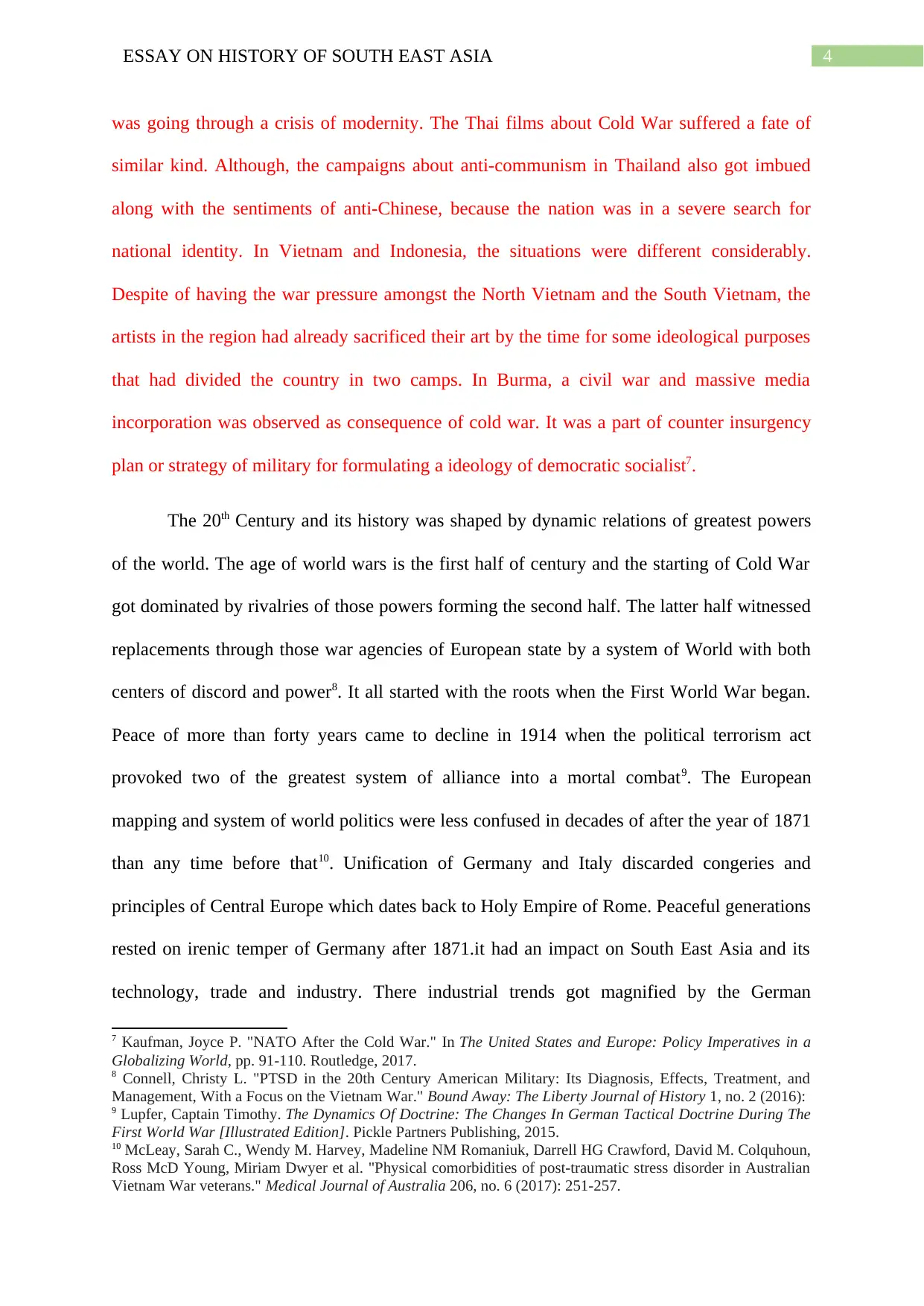
4ESSAY ON HISTORY OF SOUTH EAST ASIA
was going through a crisis of modernity. The Thai films about Cold War suffered a fate of
similar kind. Although, the campaigns about anti-communism in Thailand also got imbued
along with the sentiments of anti-Chinese, because the nation was in a severe search for
national identity. In Vietnam and Indonesia, the situations were different considerably.
Despite of having the war pressure amongst the North Vietnam and the South Vietnam, the
artists in the region had already sacrificed their art by the time for some ideological purposes
that had divided the country in two camps. In Burma, a civil war and massive media
incorporation was observed as consequence of cold war. It was a part of counter insurgency
plan or strategy of military for formulating a ideology of democratic socialist7.
The 20th Century and its history was shaped by dynamic relations of greatest powers
of the world. The age of world wars is the first half of century and the starting of Cold War
got dominated by rivalries of those powers forming the second half. The latter half witnessed
replacements through those war agencies of European state by a system of World with both
centers of discord and power8. It all started with the roots when the First World War began.
Peace of more than forty years came to decline in 1914 when the political terrorism act
provoked two of the greatest system of alliance into a mortal combat9. The European
mapping and system of world politics were less confused in decades of after the year of 1871
than any time before that10. Unification of Germany and Italy discarded congeries and
principles of Central Europe which dates back to Holy Empire of Rome. Peaceful generations
rested on irenic temper of Germany after 1871.it had an impact on South East Asia and its
technology, trade and industry. There industrial trends got magnified by the German
7 Kaufman, Joyce P. "NATO After the Cold War." In The United States and Europe: Policy Imperatives in a
Globalizing World, pp. 91-110. Routledge, 2017.
8 Connell, Christy L. "PTSD in the 20th Century American Military: Its Diagnosis, Effects, Treatment, and
Management, With a Focus on the Vietnam War." Bound Away: The Liberty Journal of History 1, no. 2 (2016):
9 Lupfer, Captain Timothy. The Dynamics Of Doctrine: The Changes In German Tactical Doctrine During The
First World War [Illustrated Edition]. Pickle Partners Publishing, 2015.
10 McLeay, Sarah C., Wendy M. Harvey, Madeline NM Romaniuk, Darrell HG Crawford, David M. Colquhoun,
Ross McD Young, Miriam Dwyer et al. "Physical comorbidities of post‐traumatic stress disorder in Australian
Vietnam War veterans." Medical Journal of Australia 206, no. 6 (2017): 251-257.
was going through a crisis of modernity. The Thai films about Cold War suffered a fate of
similar kind. Although, the campaigns about anti-communism in Thailand also got imbued
along with the sentiments of anti-Chinese, because the nation was in a severe search for
national identity. In Vietnam and Indonesia, the situations were different considerably.
Despite of having the war pressure amongst the North Vietnam and the South Vietnam, the
artists in the region had already sacrificed their art by the time for some ideological purposes
that had divided the country in two camps. In Burma, a civil war and massive media
incorporation was observed as consequence of cold war. It was a part of counter insurgency
plan or strategy of military for formulating a ideology of democratic socialist7.
The 20th Century and its history was shaped by dynamic relations of greatest powers
of the world. The age of world wars is the first half of century and the starting of Cold War
got dominated by rivalries of those powers forming the second half. The latter half witnessed
replacements through those war agencies of European state by a system of World with both
centers of discord and power8. It all started with the roots when the First World War began.
Peace of more than forty years came to decline in 1914 when the political terrorism act
provoked two of the greatest system of alliance into a mortal combat9. The European
mapping and system of world politics were less confused in decades of after the year of 1871
than any time before that10. Unification of Germany and Italy discarded congeries and
principles of Central Europe which dates back to Holy Empire of Rome. Peaceful generations
rested on irenic temper of Germany after 1871.it had an impact on South East Asia and its
technology, trade and industry. There industrial trends got magnified by the German
7 Kaufman, Joyce P. "NATO After the Cold War." In The United States and Europe: Policy Imperatives in a
Globalizing World, pp. 91-110. Routledge, 2017.
8 Connell, Christy L. "PTSD in the 20th Century American Military: Its Diagnosis, Effects, Treatment, and
Management, With a Focus on the Vietnam War." Bound Away: The Liberty Journal of History 1, no. 2 (2016):
9 Lupfer, Captain Timothy. The Dynamics Of Doctrine: The Changes In German Tactical Doctrine During The
First World War [Illustrated Edition]. Pickle Partners Publishing, 2015.
10 McLeay, Sarah C., Wendy M. Harvey, Madeline NM Romaniuk, Darrell HG Crawford, David M. Colquhoun,
Ross McD Young, Miriam Dwyer et al. "Physical comorbidities of post‐traumatic stress disorder in Australian
Vietnam War veterans." Medical Journal of Australia 206, no. 6 (2017): 251-257.

5ESSAY ON HISTORY OF SOUTH EAST ASIA
demography that was too far and the fastest growing power of economy in the continent. It
was not the only case into the basic coal industry but also into advanced chemicals, electrical,
internal combustion and other fields. The revolution of warfare pre planned where weapons
systems of research and development were introduced. The social rifts also got hardened
during this period.
Conclusion
However it concludes that cold war has done severe chaos to not only in South East
Asia but also the world. Although, The American contest of military with China holds the
power of defining the 21st century. China tends to become a more intimidating adversary as
compared to Russia ever was. The arrival of future has begun and it is no less than a new cold
war. The consistent interminable computer hacks of China in American warships of record
maintenance records of personal pentagon and other constituents of war by some other means
is introducing a tendency of provoking new wars11. The situation will only become worse and
the smiling markets of trade between Chinese and American presidents. The new beginning
of cold war seems to be permanent because of general factors and strategies of financial
community and business grounds12. This will lead to newer chaos and conflicts that will
obviously have an impact on the common people over the world especially in the host
countries. It will wither make the world come out of war and find new developed
opportunities or get doomed in war.
11 Allison, Graham. "China vs. America: managing the next clash of civilizations." Foreign Aff. 96 (2017): 80.
12 Martin, Andrew J., Kai Yu, Paul Ginns, and Brad Papworth. "Young people’s academic buoyancy and
adaptability: A cross-cultural comparison of China with North America and the United Kingdom." Educational
Psychology 37, no. 8 (2017): 930-946.
demography that was too far and the fastest growing power of economy in the continent. It
was not the only case into the basic coal industry but also into advanced chemicals, electrical,
internal combustion and other fields. The revolution of warfare pre planned where weapons
systems of research and development were introduced. The social rifts also got hardened
during this period.
Conclusion
However it concludes that cold war has done severe chaos to not only in South East
Asia but also the world. Although, The American contest of military with China holds the
power of defining the 21st century. China tends to become a more intimidating adversary as
compared to Russia ever was. The arrival of future has begun and it is no less than a new cold
war. The consistent interminable computer hacks of China in American warships of record
maintenance records of personal pentagon and other constituents of war by some other means
is introducing a tendency of provoking new wars11. The situation will only become worse and
the smiling markets of trade between Chinese and American presidents. The new beginning
of cold war seems to be permanent because of general factors and strategies of financial
community and business grounds12. This will lead to newer chaos and conflicts that will
obviously have an impact on the common people over the world especially in the host
countries. It will wither make the world come out of war and find new developed
opportunities or get doomed in war.
11 Allison, Graham. "China vs. America: managing the next clash of civilizations." Foreign Aff. 96 (2017): 80.
12 Martin, Andrew J., Kai Yu, Paul Ginns, and Brad Papworth. "Young people’s academic buoyancy and
adaptability: A cross-cultural comparison of China with North America and the United Kingdom." Educational
Psychology 37, no. 8 (2017): 930-946.
⊘ This is a preview!⊘
Do you want full access?
Subscribe today to unlock all pages.

Trusted by 1+ million students worldwide
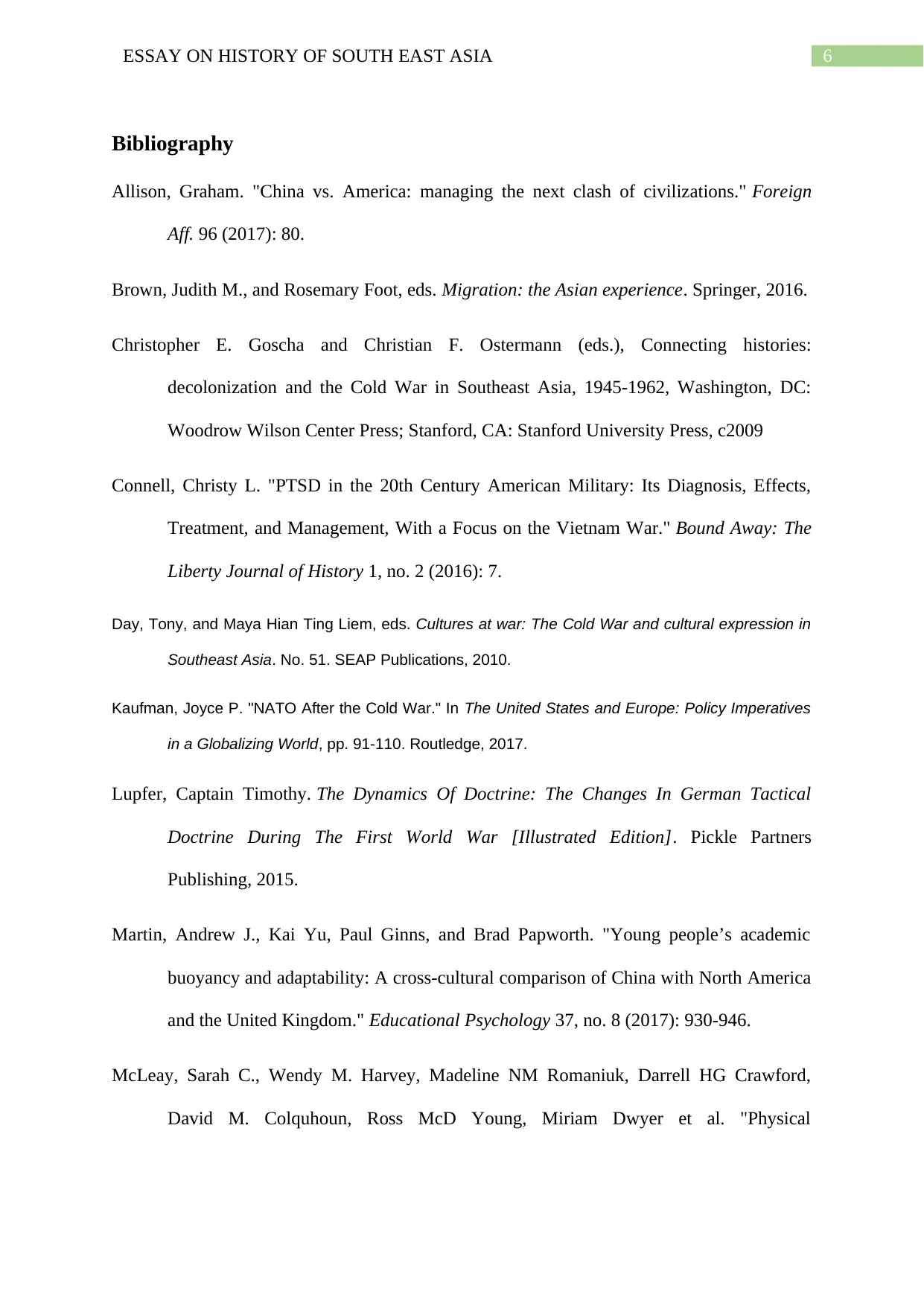
6ESSAY ON HISTORY OF SOUTH EAST ASIA
Bibliography
Allison, Graham. "China vs. America: managing the next clash of civilizations." Foreign
Aff. 96 (2017): 80.
Brown, Judith M., and Rosemary Foot, eds. Migration: the Asian experience. Springer, 2016.
Christopher E. Goscha and Christian F. Ostermann (eds.), Connecting histories:
decolonization and the Cold War in Southeast Asia, 1945-1962, Washington, DC:
Woodrow Wilson Center Press; Stanford, CA: Stanford University Press, c2009
Connell, Christy L. "PTSD in the 20th Century American Military: Its Diagnosis, Effects,
Treatment, and Management, With a Focus on the Vietnam War." Bound Away: The
Liberty Journal of History 1, no. 2 (2016): 7.
Day, Tony, and Maya Hian Ting Liem, eds. Cultures at war: The Cold War and cultural expression in
Southeast Asia. No. 51. SEAP Publications, 2010.
Kaufman, Joyce P. "NATO After the Cold War." In The United States and Europe: Policy Imperatives
in a Globalizing World, pp. 91-110. Routledge, 2017.
Lupfer, Captain Timothy. The Dynamics Of Doctrine: The Changes In German Tactical
Doctrine During The First World War [Illustrated Edition]. Pickle Partners
Publishing, 2015.
Martin, Andrew J., Kai Yu, Paul Ginns, and Brad Papworth. "Young people’s academic
buoyancy and adaptability: A cross-cultural comparison of China with North America
and the United Kingdom." Educational Psychology 37, no. 8 (2017): 930-946.
McLeay, Sarah C., Wendy M. Harvey, Madeline NM Romaniuk, Darrell HG Crawford,
David M. Colquhoun, Ross McD Young, Miriam Dwyer et al. "Physical
Bibliography
Allison, Graham. "China vs. America: managing the next clash of civilizations." Foreign
Aff. 96 (2017): 80.
Brown, Judith M., and Rosemary Foot, eds. Migration: the Asian experience. Springer, 2016.
Christopher E. Goscha and Christian F. Ostermann (eds.), Connecting histories:
decolonization and the Cold War in Southeast Asia, 1945-1962, Washington, DC:
Woodrow Wilson Center Press; Stanford, CA: Stanford University Press, c2009
Connell, Christy L. "PTSD in the 20th Century American Military: Its Diagnosis, Effects,
Treatment, and Management, With a Focus on the Vietnam War." Bound Away: The
Liberty Journal of History 1, no. 2 (2016): 7.
Day, Tony, and Maya Hian Ting Liem, eds. Cultures at war: The Cold War and cultural expression in
Southeast Asia. No. 51. SEAP Publications, 2010.
Kaufman, Joyce P. "NATO After the Cold War." In The United States and Europe: Policy Imperatives
in a Globalizing World, pp. 91-110. Routledge, 2017.
Lupfer, Captain Timothy. The Dynamics Of Doctrine: The Changes In German Tactical
Doctrine During The First World War [Illustrated Edition]. Pickle Partners
Publishing, 2015.
Martin, Andrew J., Kai Yu, Paul Ginns, and Brad Papworth. "Young people’s academic
buoyancy and adaptability: A cross-cultural comparison of China with North America
and the United Kingdom." Educational Psychology 37, no. 8 (2017): 930-946.
McLeay, Sarah C., Wendy M. Harvey, Madeline NM Romaniuk, Darrell HG Crawford,
David M. Colquhoun, Ross McD Young, Miriam Dwyer et al. "Physical
Paraphrase This Document
Need a fresh take? Get an instant paraphrase of this document with our AI Paraphraser
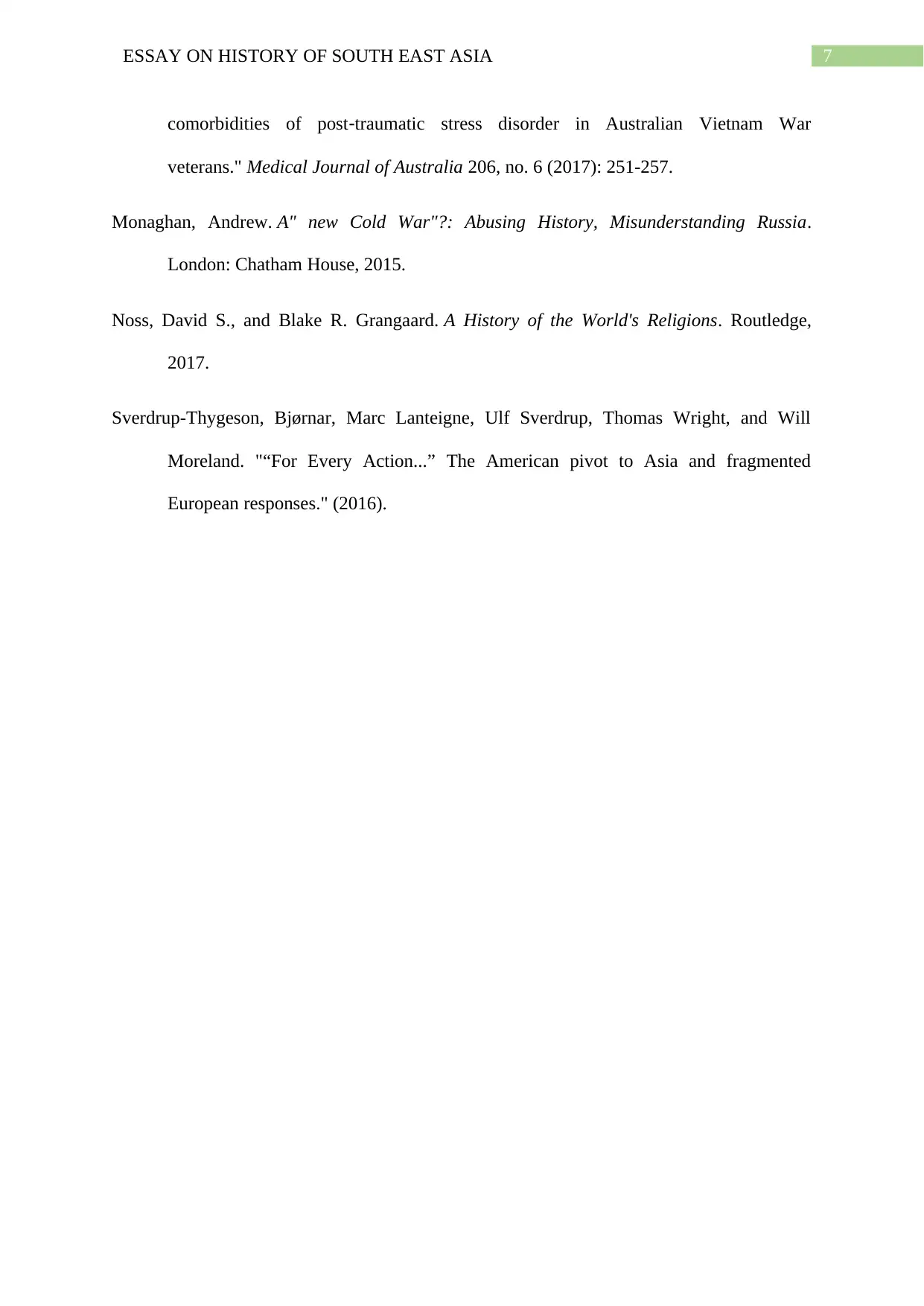
7ESSAY ON HISTORY OF SOUTH EAST ASIA
comorbidities of post‐traumatic stress disorder in Australian Vietnam War
veterans." Medical Journal of Australia 206, no. 6 (2017): 251-257.
Monaghan, Andrew. A" new Cold War"?: Abusing History, Misunderstanding Russia.
London: Chatham House, 2015.
Noss, David S., and Blake R. Grangaard. A History of the World's Religions. Routledge,
2017.
Sverdrup-Thygeson, Bjørnar, Marc Lanteigne, Ulf Sverdrup, Thomas Wright, and Will
Moreland. "“For Every Action...” The American pivot to Asia and fragmented
European responses." (2016).
comorbidities of post‐traumatic stress disorder in Australian Vietnam War
veterans." Medical Journal of Australia 206, no. 6 (2017): 251-257.
Monaghan, Andrew. A" new Cold War"?: Abusing History, Misunderstanding Russia.
London: Chatham House, 2015.
Noss, David S., and Blake R. Grangaard. A History of the World's Religions. Routledge,
2017.
Sverdrup-Thygeson, Bjørnar, Marc Lanteigne, Ulf Sverdrup, Thomas Wright, and Will
Moreland. "“For Every Action...” The American pivot to Asia and fragmented
European responses." (2016).
1 out of 8
Related Documents
Your All-in-One AI-Powered Toolkit for Academic Success.
+13062052269
info@desklib.com
Available 24*7 on WhatsApp / Email
![[object Object]](/_next/static/media/star-bottom.7253800d.svg)
Unlock your academic potential
Copyright © 2020–2025 A2Z Services. All Rights Reserved. Developed and managed by ZUCOL.





